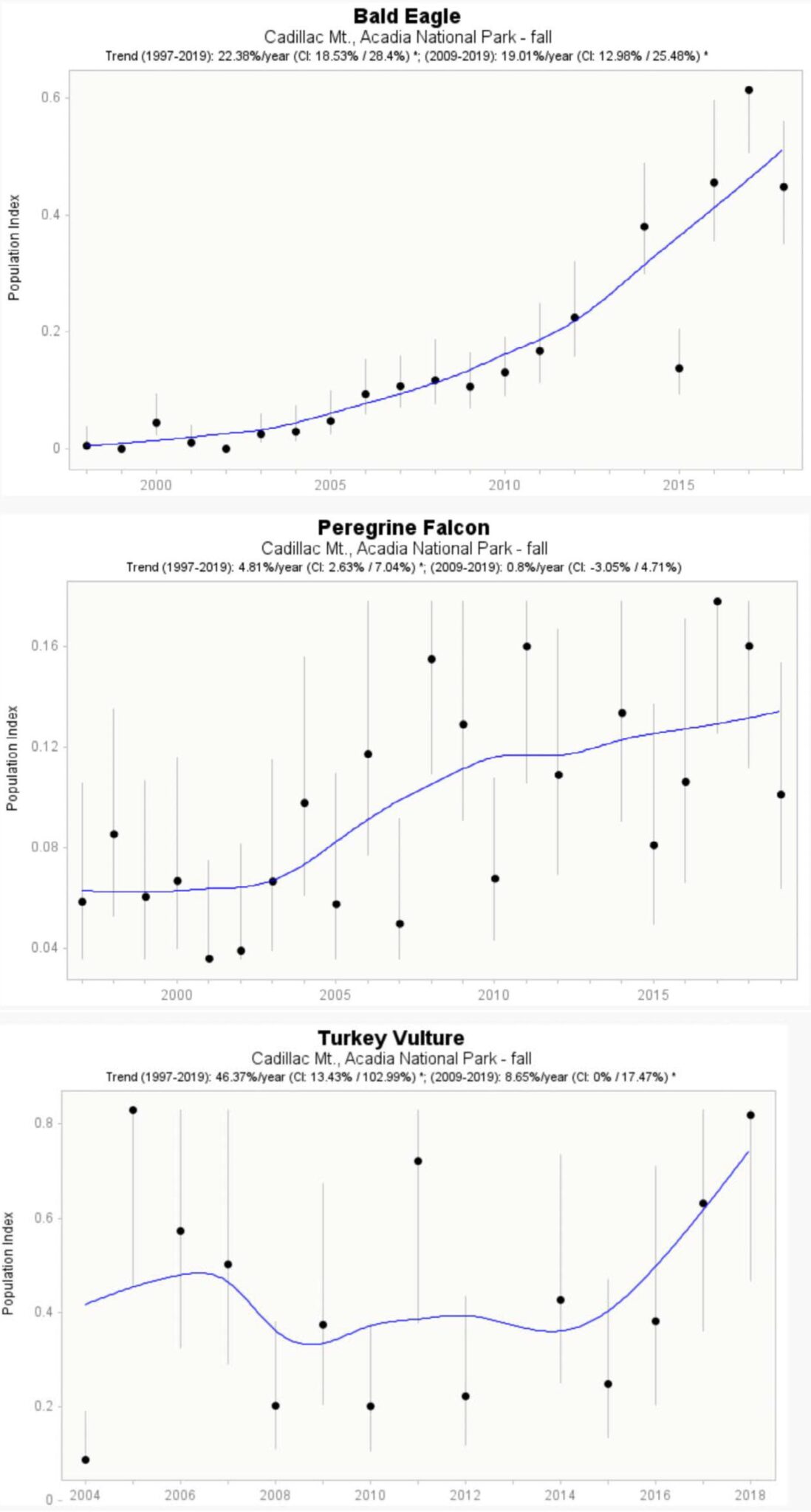This story was originally published by Maine Natural History Observatory
By Seth Benz
Volunteers counted 1,949 hawks during the 30th season of the Cadillac Mountain Hawk Watch in Acadia National Park. Their 248.75 hours of observation yielded a total of 7.8 hawks per hour, reported to an online database administered by the Hawk Migration Association of North America.
Table 1. Cadillac Mountain Hawk Watch monthly totals for 2024

The consistency of the effort, which extended 64 days from August 13 through November 14, is accomplished by a dedicated group of volunteers. The Lead Volunteer Counter was Angi King-Johnston who accrued an amazing 220 hours of coverage. Volunteer spotters included Jim and Kathy Zeman, Holly and Monty Evans, and Chris and Joe Ferrara. The total cumulative number of volunteer hours was 414. Acadia National Park’s raptor intern, Sara York, and other interpreters were present on at least two days per week for three hours each day from early September through mid-October, helping to greet and orient 4,693 visitors over the four months of hawk watching.
Table 2 depicts the total number of hawks counted each autumn since 1995. The lowest total (1,469) was in 1996. The highest total (5,422) was in 2011.
Table 2. Cadillac Mountain Hawk Watch annual fall migration totals for 1995 to 2024

Select Cadillac Mountain Hawk Watch Species Trends
Raptor populations and migration pathways can vary annually, influenced by prey abundance, weather, and other environmental factors. These species trends are derived from statistical analysis by the Raptor Population Index.
Species Showing Declines


 Each of these species are seen regularly from Cadillac Mountain during fall migration. The most numerous migrants are Sharp-shinned Hawk, which lives in forests, and American Kestrel, which favors grasslands and fields. Northern Harrier prefers wetland edges. Populations of these raptors were adversely impacted by the pesticide DDT and other chemicals and rebounded following the ban of DDT in the 1970s. However, all have declined again since then. Sharp-shinned Hawk and American Kestrel began to show declines beginning in the 1990s, the Northern Harrier’s decline began just prior to 2010. Despite the differences in preferred habitats, the populations of each of these species now share similar declining population impacts from threats such as habitat loss, environmental contaminants, collisions with buildings and vehicles, loss of prey species, and infectious diseases, especially West Nile Virus. Northern Harrier decline points more directly to loss of habitat due to the continued, widespread loss of healthy wetland and marshland ecosystems, though infectious disease is also cited. More research is needed to determine the extent to which West Nile virus has impacted raptor populations.
Each of these species are seen regularly from Cadillac Mountain during fall migration. The most numerous migrants are Sharp-shinned Hawk, which lives in forests, and American Kestrel, which favors grasslands and fields. Northern Harrier prefers wetland edges. Populations of these raptors were adversely impacted by the pesticide DDT and other chemicals and rebounded following the ban of DDT in the 1970s. However, all have declined again since then. Sharp-shinned Hawk and American Kestrel began to show declines beginning in the 1990s, the Northern Harrier’s decline began just prior to 2010. Despite the differences in preferred habitats, the populations of each of these species now share similar declining population impacts from threats such as habitat loss, environmental contaminants, collisions with buildings and vehicles, loss of prey species, and infectious diseases, especially West Nile Virus. Northern Harrier decline points more directly to loss of habitat due to the continued, widespread loss of healthy wetland and marshland ecosystems, though infectious disease is also cited. More research is needed to determine the extent to which West Nile virus has impacted raptor populations.
Species Showing Increases

Any visit to Cadillac Mountain during fall migration (mid August to November) is sure to provide a sighting or two of Turkey Vulture. Bald Eagles and Peregrine Falcons can also be seen but with less consistency. Each of these species have benefited from human intervention. Turkey Vultures have expanded northward apparently prospering due to warming seasonal temperatures and increasing road-killed animals along heavily traveled roads and highways. Eagles and Peregrine Falcons received direct population bolstering assistance via transplanted nestling reintroduction efforts. Geographically, eastern North America, over the past few decades, has witnessed widespread nesting success of both species. The Cadillac Mountain Hawk Watch results over the past two decades of counting reveal that Bald Eagle numbers have increased from an average of 44 (2005-2014) to 112 (2015-2024); Turkey Vultures have increased from 86 (2005-2014) to 172 (2015-2024); however, a Peregrine Falcon analysis reveals a slight surge in the average migration numbers from 2005-2014 (25) than this past decade 2014- 2024 (21). The 2024 total of 8 Peregrine Falcons is the lowest count over the span of the last 22 years. Despite documented rising numbers of fledged peregrines at nest sites in the Acadia region, this year’s low migration number is a speculative mystery.
Schoodic Institute scientists and Acadia National Park staff and volunteers have been documenting the annual migration past Cadillac Mountain since 1995. They record and maintain counts of migrating raptors each autumn, and also count other migrants, including monarch butterflies, dragonflies, and songbirds. Thousands of visitors to the migration counting station on Cadillac Mountain are introduced to the phenomenon of migration, and many look to the sky to help with observations. The sightings are recorded in a database to eventually assist the park and the Hawk Migration Association in identifying sensitive species that might need more specific research. The select species trend analyses highlight an unfolding story. We look forward to ongoing effort to continue the long-term monitoring of hawk migration atop Cadillac Mountain.

